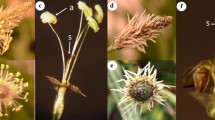Abstract
Pistil development was studied in transgenic tobacco plants in which the stigma is ablated by expression of a stigma-specific cytotoxic gene. These plants offer a tool to investigate the process of differentiation of the secretory zone, in that cell death caused by barnase activity provides a marker to follow cell fate at high resolution. After fusion of the carpel walls in the region most distal from the ovary, the epidermal cells begin to divide in both wild-type and stigmaless plants. Divisions of the L1 layer of the pistil are immediately followed by the morphogenetic events that lead to three different cell types: rounded-angular cells showing an equal number of anti- and periclinal divisions, cells that are more oblong forming the transition zone, and the square cells of the transmitting tissue dividing mostly anticlinally with respect to the original carpel wall. In the stigmaless plants, cell death caused by the expression ofSTIG 1-barnase begins at stage −1 and proceeds gradually, but is always associated with round epidermal cells and with angular-rounded cells underneath them. Studies at the ultrastructural level show that cell death caused by barnase activity occurs first in solitary cells and gradually extends to groups of cells.In situ hybridizations using the STIG 1 RNA probe in wild-type pistils confirm these results. Most likely, the cells in whichSTIG 1 is expressed are those that have just differentiated into the secretory cell type. Our results indicate that the transition zone or neck is autonomously differentiated from the secretory zone and the transmitting tissue. Furthermore, our results indicate that in both wild-type and stigmaless pistils secretion of lipids most likely occurs through the plasmodesmata. This observation suggests that bulk transport can occur via plasmodesmata.
Similar content being viewed by others

References
Almeida-Engler J de, Montagu M van, Engler G (1994) Hybridization in situ of whole-mount messenger RNA in plants. Plant Mol Biol Rep 12: 321–331
Atkinson AH, Lind JL, Clarke E, Anderson MA (1993) Molecular and structural features of the pistil ofNicotiana alata. Biochem Soc Symp 60: 15–26
Berg C van den, Willemsen V, Hage W, Welsbeek P, Scheres B (1995) Cell fate in theArabidopsis root meristem determined by directional signalling. Nature 378: 62–65
Cresti M, Keijzer CJ, Tiezzi A, Ciampolini F, Focardi S (1986) Stigma ofNicotiana: ultrastructural and biochemical studies. Am J Bot 73: 1713–1722
Dumas C (1977) Lipochemistry of the programmic stage of a self-incompatible species: neutral lipids and fatty acids of the secretory stigma during its glandular activity, and of the solid style, the ovary and the anther onForsythia intermedia Zab. Planta 137:177–184
Dumas C, Rougier M, Zandonella P, Ciampolini F, Cresti M, Pacini E (1978) The secretory stigma inLycopersicon peruvianum Mill.: ontogenesis and glandular activity. Protoplasma 96: 173–187
Epel BL (1994) Plasmodesmata: composition, structure and trafficking. Plant Mol Biol 26: 1343–1356
Franceschi VR, Lucas WJ (1982) The relationship of the charasome to chloride uptake inChara corallina: physiological and histochemical investigations. Planta 154: 525–537
Goldman MHS, Goldberg RB, Mariani C (1994) Female sterile tobacco plants are produced by stigma-specific cell ablation. EMBO J 13: 2976–2984
Herrero M, Dickinson HG (1979) Pollen-pistil incompatibility inPetunia hybrida: changes in the pistil following compatible intraspecific crosses. J Cell Sci 36: 1–18
Heslop-Harrison J, Heslop-Harrison Y (1983) Pollen-stigma interaction in Leguminosae: the organization of the stigma inTrifolium pratense L. Ann Bot 51: 571–583
Heslop-Harrison Y, Shivanna KR (1977) The receptive surface of the angiosperm stigma. Ann Bot 41: 1233–1258
Kadej AJ, Wilms HJ, Willemse MTM (1985) Stigma and stigmatoid tissue ofLycopersicon esculentum Mil. Acta Bot Neerl 34: 95–103
Kang F, Rawsthrone S (1994) Starch and fatty acid synthesis in plastids from developing embryos of oilseed rape (Brassica napus L.). Plant J 6: 795–805
Kandasamy MK, Kristen U (1987) Developmental aspects of ultrastructure, histochemistry and receptivity of the stigma of Nicotiana sylvestris. Ann Bot 60: 427–437
Knox RB (1984) Pollen-pistil interaction. In: Linskens HF, Heslop-Harrison J (eds) Cellular interactions. Springer, Berlin Heidelberg New York, pp 508–608
Koltunow AM, Truettner J, Cox KH, Wallroth M, Goldberg RB (1990) Different temporal and spatial gene expression patterns occur during anther development. Plant Cell 2: 1201–1224
Laskowski MJ, Williams ME, Nusbaum HC, Sussex IM (1995) Formation of lateral root meristems is a two-stage process. Development 121: 3303–3310
Lucas WJ, Ding B, Schoot C van der (1993) Plasmodesmata and the supracellular nature of plants. New Phytol 125: 435–476
Mackenzie JC, Yoo BY, Seabrook JEA (1990) Stigma ofSolanum tuberosum cv. Shepody; morphology, ultrastructure and secretion. Am J Bot 77: 1111–1124
Satina S (1944) Periclinal chimeras inDatura in relation to development and structure of the style and stigma of calyx and corolla. Am J Bot 31: 493–502
Scheres B, Wiel C van de, Zalensky A, Horvath B, Spaink H, Eck H van, Zwartkruis F, Wolters AM, Gloudemans T, Kammen A van, Bisseling T (1990) The ENOD12 gene product is involved in the infection process during the Pea-Rhizobium interaction. Cell 60: 281–294
Schiefelbein JW (1994) Cell fate and cell morphogenesis in higher plants. Curr Opin Genet Dev 4: 647–651
Schou O, Mattson O (1985) Differential localisation of enzymes in the stigmatic exudates ofPrimula obconica. Protoplasma 125: 65–74
Sedgley M, Blesing MA (1983) Developmental anatomy of the advocado stigma papilla cells and their secretion. Bot Gaz 144:185–190
Thorsness MK, Muthugapatti K, Kandasamy K, Nasrallah ME, Nasrallah JB (1991) ABrassica S-locus gene promotor targets toxic gene expression and cell death to the pistil and pollen of transgenicNicotiana. Dev Biol 143: 173–184
Trevithik JR, Metzenberg RL (1960) Molecular sieving byNeurospora cell walls during secretion of invertase isozymes. J Bacteriol 92: 1010–1015
Author information
Authors and Affiliations
Corresponding author
Rights and permissions
About this article
Cite this article
Wolters-Arts, M., Derksen, J., Kooijman, J.W. et al. Stigma development in Nicotiana tabacum. Cell death in transgenic plants as a marker to follow cell fate at high resolution. Sexual Plant Reprod 9, 243–254 (1996). https://doi.org/10.1007/BF02152698
Received:
Accepted:
Issue Date:
DOI: https://doi.org/10.1007/BF02152698



